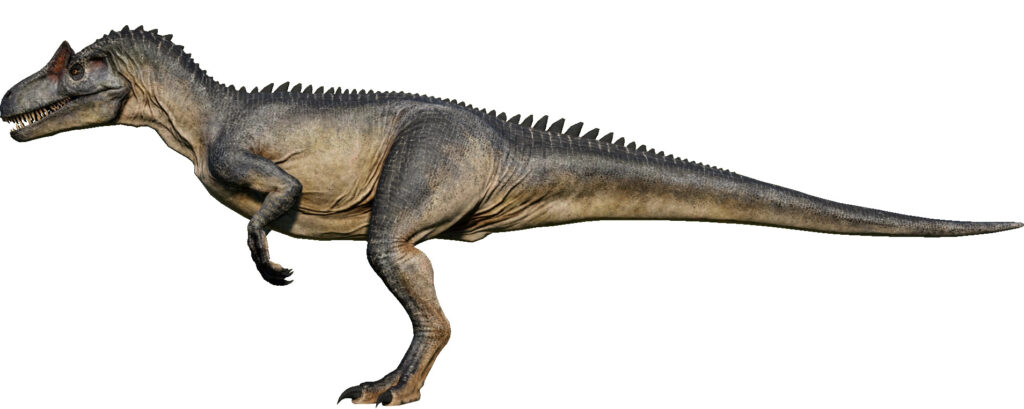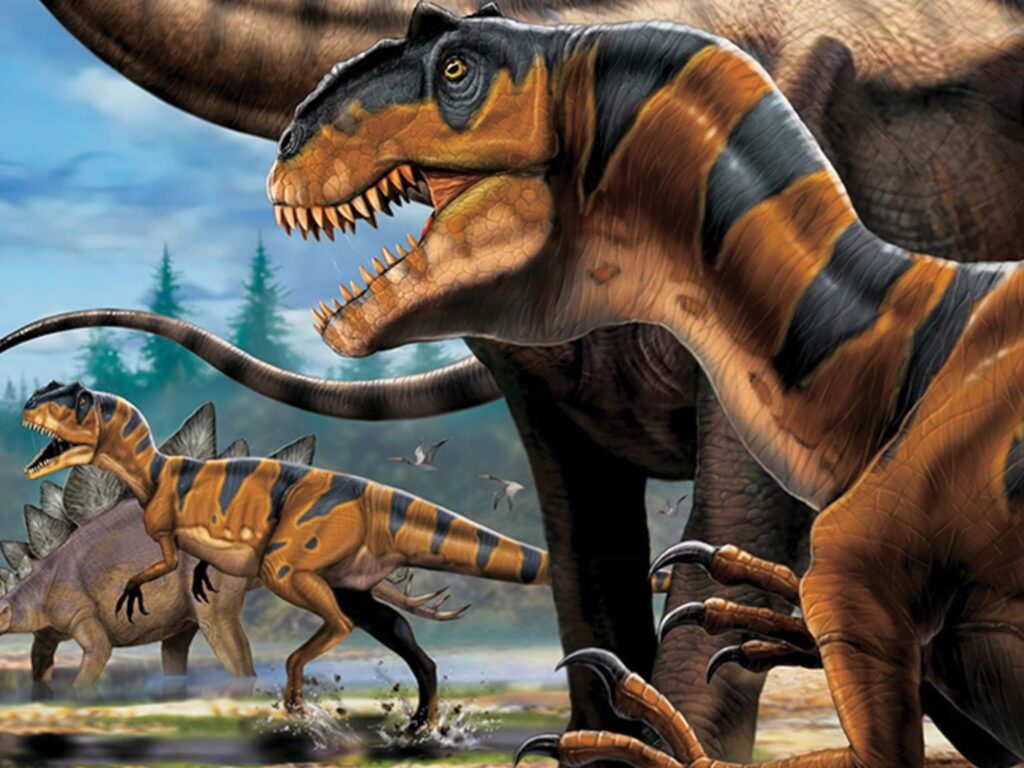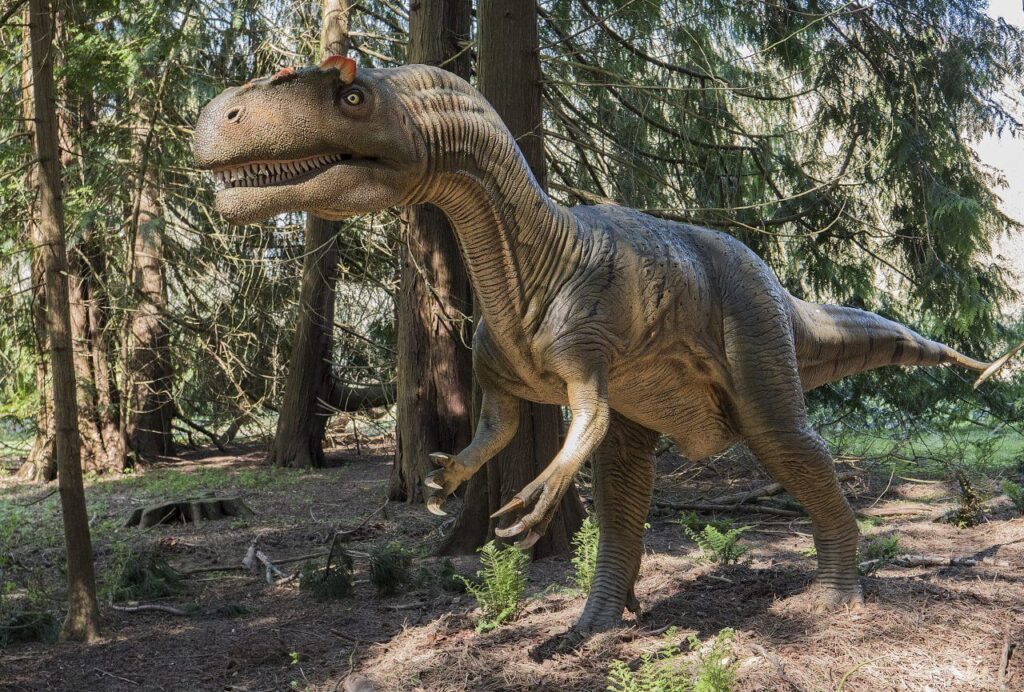Introduction
Welcome to the mesmerizing world of Allosaurus, the apex predator of the Late Jurassic period. In this extensive article, we will embark on a thrilling journey to uncover the mysteries surrounding this incredible creature that once roamed the Earth. From its physical characteristics to its hunting strategies, we’ll delve deep into the life and times of Allosaurus.
What is Allosaurus?
Allosaurus, scientifically known as “Allosaurus fragilis,” was a fearsome dinosaur that lived approximately 155 to 150 million years ago during the Late Jurassic period. Its name, which means “different lizard,” aptly describes its unique features that set it apart from other dinosaurs of its time.
Key Attributes of Allosaurus

| Name | Allosaurus |
|---|---|
| Size | Approximately 9 to 12 meters (30 to 39 feet) in length |
| Age | Late Jurassic (approximately 155 to 150 million years ago) |
| Diet | Carnivorous, primarily preying on large herbivorous dinosaurs |
| Classification | Kingdom: Animalia, Phylum: Chordata, Class: Sauropsida, Superorder: Dinosauria, Order: Saurischia, Suborder: Theropoda, Family: Allosauridae, Genus: Allosaurus |
| Habitat | Varied environments including forests, plains, and riverbanks |
| Distribution | Found in North America, specifically in what is now the western United States |
| Unique Features | Large size, powerful jaws with serrated teeth, and three-fingered hands |
| Behavior | Apex predator, believed to be a skilled hunter and scavenger |
| Prey | Hunted large herbivorous dinosaurs like sauropods and stegosaurs |
| Cultural Significance | One of the most well-known and studied theropod dinosaurs |
| Fossil Record | Well-preserved fossils discovered in North America, providing extensive knowledge about its anatomy and behavior |
Allosaurus is renowned as one of the top predators of the Late Jurassic period and is a significant species in the study of theropod dinosaurs.
Physical Characteristics
Size and Anatomy
Allosaurus was a formidable carnivore, reaching lengths of up to 40 feet and standing about 15 feet tall. Its body was lean and muscular, built for agility and speed. It featured a large skull with sharp teeth, designed for tearing flesh.
The skull of Allosaurus was a masterpiece of evolution. It was large, accounting for about a quarter of the entire body length. This massive skull housed rows of serrated teeth that were perfectly adapted for slicing through the flesh of its prey. These teeth, some measuring up to 4 inches in length, were finely serrated, which aided in cutting through tough dinosaur hide and bone.
Arms and Claws
One of the distinguishing features of Allosaurus was its powerful arms with three sharp claws on each hand. These claws were invaluable in grasping and immobilizing prey, giving Allosaurus a significant advantage in the predator-prey arms race.
The claws of Allosaurus were like natural daggers, capable of inflicting deep wounds on its prey. These adaptations allowed Allosaurus to securely hold onto its quarry while delivering fatal bites.
Tail and Limbs
Allosaurus had a long, muscular tail that provided balance and stability while chasing prey. Its hind limbs were powerful and built for running, enabling it to reach impressive speeds for a dinosaur of its size. This combination of attributes made Allosaurus a highly efficient predator.
Habitat and Distribution

Geographic Range
Fossils of Allosaurus have been discovered in North America, particularly in regions that are now part of the United States, including Utah, Colorado, and Wyoming. These findings suggest that Allosaurus was a widespread predator in its time.
Preferred Environments
Allosaurus inhabited a range of environments, from forests to plains. Its ability to adapt to different habitats made it a versatile predator. This adaptability likely contributed to its success in the Late Jurassic ecosystem.
Feeding Habits
Carnivorous Diet
Allosaurus was a carnivorous dinosaur, meaning it exclusively consumed meat. Its diet likely consisted of smaller dinosaurs and other terrestrial animals of its era. It would have been a formidable predator, preying on herbivorous dinosaurs like Stegosaurus and Apatosaurus.
Hunting Strategies
The Allosaurus employed various hunting techniques, including ambush predation and pack hunting. Its agility and speed, combined with its sharp claws and powerful jaws, made it a formidable predator.
Allosaurus was an apex predator, which means it was at the top of the food chain. Its hunting strategies were well-honed, allowing it to take down even the largest of prey. Its ability to work in groups, as suggested by some paleontologists, would have made it an even more formidable force in the Late Jurassic ecosystem.
Paleoenvironment of the Late Jurassic
Climate and Geography
To truly appreciate the world of Allosaurus, we must step back in time to the Late Jurassic period. This epoch was characterized by a specific climate and geography that shaped the environments where Allosaurus thrived. Understanding the conditions of its habitat provides a backdrop for its existence.
Coexisting Species
Allosaurus did not live in isolation. It shared its ecosystem with a diverse array of dinosaurs and prehistoric creatures. From the iconic Brachiosaurus to the smaller ornithopods, these coexisting species created a dynamic and complex environment. Investigating these interactions offers a richer view of Allosaurus’ world.
Social Behavior

Solitary or Pack Animal?
The debate continues regarding whether Allosaurus was a solitary hunter or a pack animal. Some evidence suggests that it may have hunted in groups, similar to modern-day wolves. This hypothesis is based on fossil evidence that shows multiple Allosaurus individuals buried together, possibly indicating cooperative hunting or scavenging behavior.
The idea of Allosaurus hunting in packs adds another layer of intrigue to its social behavior and hunting strategies. If true, it would have been one of the first dinosaurs known to exhibit such behavior.
Fossil Discoveries

Initial Fossil Finds
The story of Allosaurus begins with the initial fossil discoveries that captivated the imaginations of early paleontologists. The very first fossils were found in the late 19th century, primarily in the western regions of the United States. These remarkable findings marked the beginning of our journey to understand Allosaurus and its place in prehistory.
Notable Fossil Sites
Throughout the years, numerous notable fossil sites have yielded Allosaurus remains, enriching our knowledge of this dinosaur. Locations like the Morrison Formation in Colorado and the Cleveland-Lloyd Dinosaur Quarry in Utah have provided a wealth of fossils, enabling scientists to piece together the Allosaurus puzzle and gain insights into its distribution across ancient landscapes.
Extinction
The End of an Era
Around 150 million years ago, Allosaurus vanished from the Earth. The reasons for its extinction remain a subject of scientific inquiry, with theories ranging from environmental changes to competition with other predators.
The Late Jurassic period was marked by significant shifts in climate and ecosystems, and these changes may have played a role in the decline of Allosaurus. Additionally, the appearance of new, more advanced predators could have outcompeted Allosaurus for resources.
Cultural Significance
Pop Culture and Paleontology
Allosaurus has captured the imagination of people worldwide and has become a popular subject in literature, film, and television. Its portrayal in pop culture has added to its mystique.
From movies like “Jurassic Park” to documentaries exploring the lives of dinosaurs, Allosaurus is a recurring star. Its role as a fearsome predator has solidified its place in the annals of paleontology and popular culture.
Conclusion
In conclusion, Allosaurus, the “different lizard,” stands as a captivating symbol of the prehistoric world. Its physical prowess, hunting strategies, and eventual disappearance continue to fascinate scientists and enthusiasts alike. This article has provided a comprehensive look at the life and times of Allosaurus, shedding light on its remarkable adaptations and its place in the complex tapestry of Earth’s history.
Frequently Asked Questions (FAQs)
1. Were there other species of Allosaurus?
Yes, several species of Allosaurus have been identified based on fossil evidence.
2. How fast could Allosaurus run?
While exact speeds are difficult to determine, Allosaurus was likely a swift predator capable of chasing down its prey.
3. What is the closest living relative of Allosaurus?
Birds are the closest living relatives of Allosaurus, as they both belong to the dinosaur lineage.
4. Can I see Allosaurus fossils in museums?
Yes, many natural history museums around the world display Allosaurus fossils.
5. Did Allosaurus have any natural predators?
Based on current knowledge, Allosaurus was one of the top predators of its time and had few natural enemies.
This exploration of Allosaurus has only scratched the surface of the many intriguing facets of this remarkable dinosaur. To delve deeper into the world of Allosaurus, don’t hesitate to explore the wealth of resources available from paleontologists and museums worldwide. Happy dino-hunting!
